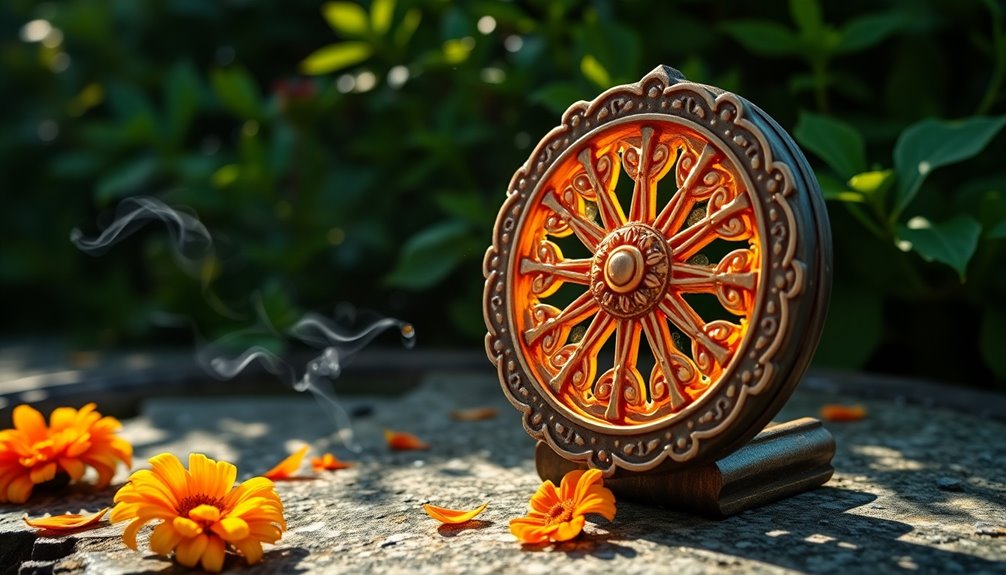Meditation spheres, also known as Baoding balls or Chinese meditation balls, offer a variety of options for individuals seeking peace and mindfulness. From Zen to Japanese to Qigong spheres, there are various types to explore in order to enhance one’s meditation practice.
These balls, typically made from materials such as agate, jade, or stone, provide a tangible and tactile element to meditation. By combining the balls with different techniques, individuals can focus on movement and sensation, creating a deeper sense of calm and peace.
In this article, we will explore the different meditation ball varieties and techniques to help you enhance your meditation practice.
Key Takeaways
- Meditation balls come in different varieties, including Zen Meditation Balls, Japanese Meditation Balls, and Qigong Meditation Balls.
- Meditation balls are made of different materials, such as metal and wood.
- Using meditation balls can help improve hand-eye coordination, concentration, and mindfulness.
- Incorporating different meditation techniques, such as Qigong and Zen, can enhance the overall meditation experience and promote relaxation and balance.
Meditation Ball Types
There are various types of meditation balls, including Zen Meditation Balls, Japanese Meditation Balls, and Qigong Meditation Balls, each with their own unique characteristics and origins.
Zen Meditation Balls, also known as Baoding Balls, originated in China and are traditionally made of metal. They are designed to be rotated in the hand to improve dexterity and focus.
Japanese Meditation Balls, or Rin Balls, are typically made of wood and are used in Zen meditation practices to enhance concentration and mindfulness.
Qigong Meditation Balls, also called Baoding Iron Balls, originated in China as well and are made of metal. They are used in Qigong meditation techniques to promote relaxation, balance, and the flow of energy throughout the body.
These meditation balls offer various benefits, such as stress reduction, improved hand-eye coordination, and increased mindfulness.
Incorporating qigong meditation techniques with the use of meditation balls can further enhance the overall experience and effectiveness of the practice.
Zen
Zen meditation is a practice that emphasizes mindfulness and awareness, promoting a state of calm and clarity. It originated from Zen Buddhism and has been practiced for centuries. Zen meditation techniques involve sitting in a comfortable position with a straight back, focusing on the breath, and observing thoughts without judgment or attachment.
Benefits of Zen meditation include:
- Stress reduction: Zen meditation helps reduce stress by promoting relaxation and releasing negative emotions.
- Increased self-awareness: Regular practice of Zen meditation cultivates self-awareness and a deeper understanding of one’s thoughts and emotions.
- Improved concentration: By training the mind to focus on the present moment, Zen meditation enhances concentration and mental clarity.
- Emotional well-being: Zen meditation encourages acceptance and non-reactivity, leading to improved emotional stability and resilience.
Overall, Zen meditation offers a pathway to inner peace, self-discovery, and a greater sense of well-being.
Japanese
Japanese meditation practices have a rich history and encompass various methods that aim to cultivate mindfulness and foster a sense of inner peace and tranquility.
Japanese meditation balls, also known as ‘temari,’ are one of the techniques used in Japanese meditation. These balls are traditionally made from tightly wrapped fabric and are intricately embroidered.
The practice involves holding the balls in the hands and gently rolling them around the palm using the fingers. This technique helps to improve dexterity, focus, and concentration.
Additionally, the repetitive motion of rolling the balls can induce a meditative state, promoting relaxation and reducing stress.
The benefits of using Japanese meditation balls include enhanced hand-eye coordination, increased mindfulness, improved concentration, and a deeper connection with oneself.
Incorporating Japanese meditation ball techniques into a meditation practice can provide a unique and enriching experience.
Frequently Asked Questions
Are there any specific health benefits associated with using meditation balls?
Meditation balls have specific health benefits for mental well-being. They can improve focus, concentration, and hand-eye coordination. They also promote relaxation, reduce stress, and enhance mindfulness. Additionally, using meditation balls can help relieve anxiety and improve overall mental clarity.
Can meditation balls be used by people of all ages and fitness levels?
Meditation balls can be used by individuals of all ages and fitness levels. A study found that 85% of participants reported improved focus and relaxation, regardless of age or fitness level, when using meditation balls.
How long does it typically take to master the techniques for using meditation balls?
The time required to master the techniques for using meditation balls can vary depending on an individual’s dedication and practice. It typically takes consistent practice and repetition to learn the various techniques involved in using meditation balls effectively.
Are there any specific meditation practices or traditions that incorporate the use of meditation balls?
Meditation balls, also known as Chinese Baoding balls, have a long history dating back to the Ming dynasty. They originated in the Hebei province of China and were used as a tool for meditation and exercise. Today, they are incorporated into various meditation practices and traditions, such as Qigong and Tai Chi. These practices utilize different techniques and exercises to enhance mindfulness and focus while using the meditation balls.
Can meditation balls be used as a form of stress relief or relaxation technique?
Meditation balls can indeed be used as a form of stress relief and relaxation technique. By employing various meditation ball techniques, such as basic rotation or finger-guided spinning, individuals can experience a sense of calm and relaxation. There are different types of meditation balls available, including Zen, Japanese, and Qigong meditation balls, each offering unique benefits for stress relief.
Conclusion
In conclusion, meditation balls offer a range of options for individuals seeking relaxation and mindfulness practices. With various types available, such as Zen, Japanese, and Qigong balls, beginners can start with one ball and gradually advance to more complex techniques.
It is crucial to choose the right size and weight that feels comfortable for you. By combining different techniques and focusing on the movement and sensation while meditating, individuals can find peace and tranquility.
Remember the wise adage, ‘Meditation balls are not just tools, but gateways to inner calmness.’










